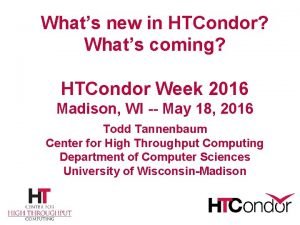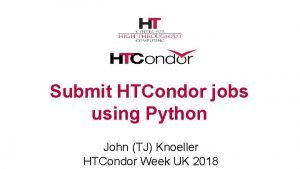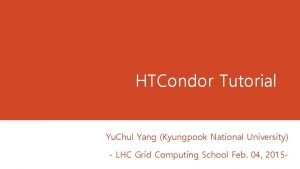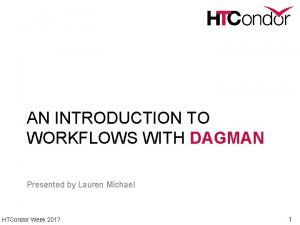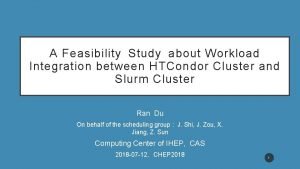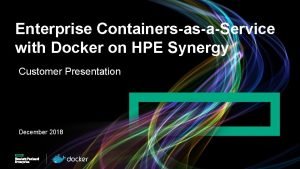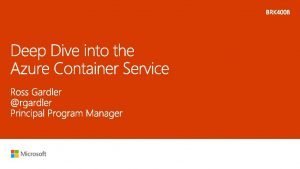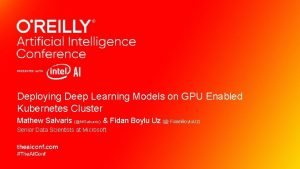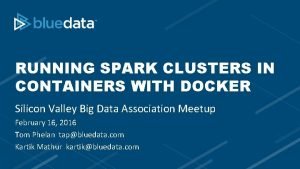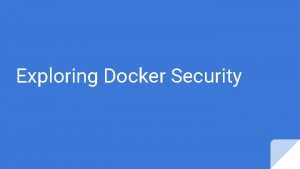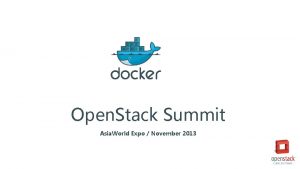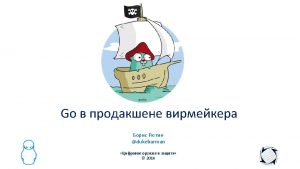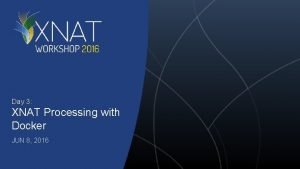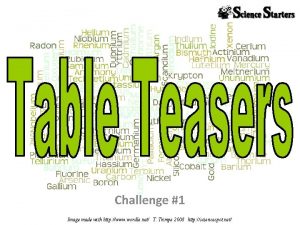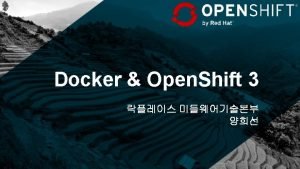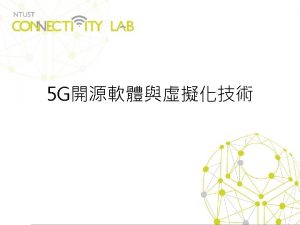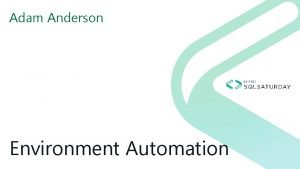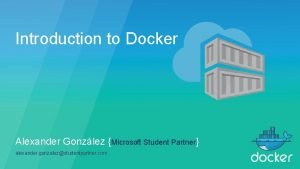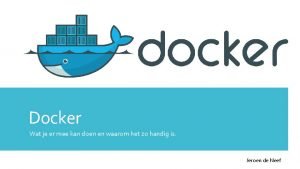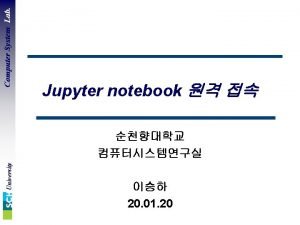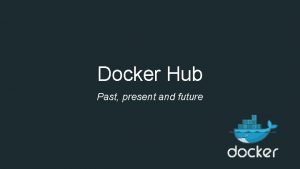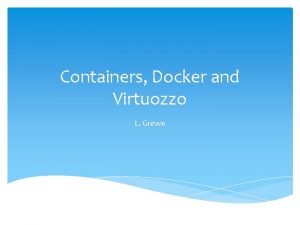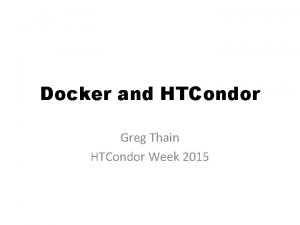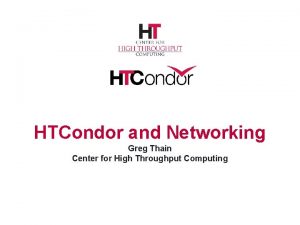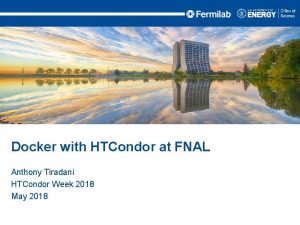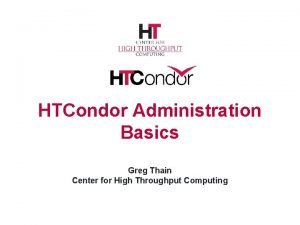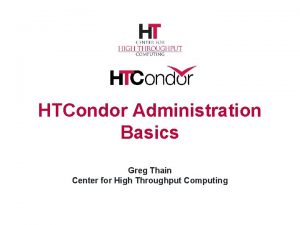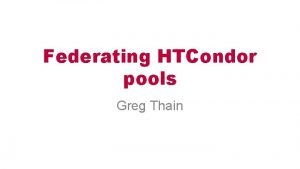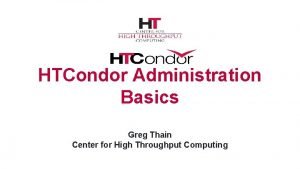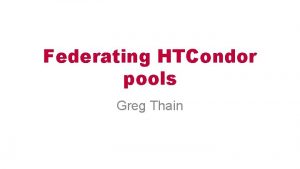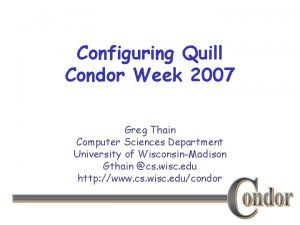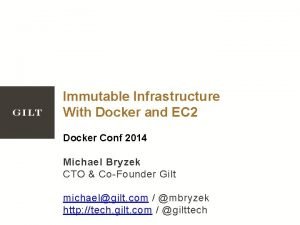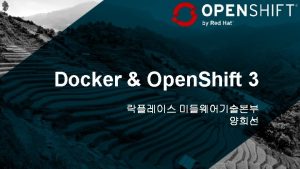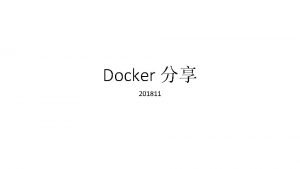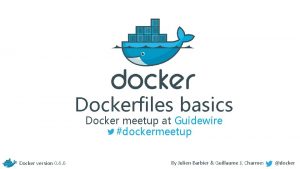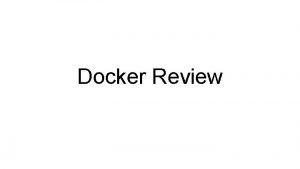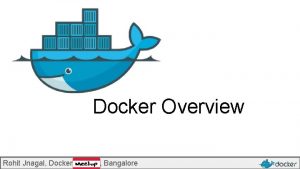Docker and HTCondor Greg Thain HTCondor Week 2016





































- Slides: 37

Docker and HTCondor Greg Thain HTCondor Week 2016

Start with the Basics… HTCondor is designed to: Allow a machine “owner” to loan it out The machine must be protected from job

Ancient History: Chroot HTCondor used to chroot every job: 1. No job could touch the file system 2. Private files in host machine stayed private

Chroot: more trouble than value Increasingly difficult to work: Shared libraries /dev /sys /etc /var/run pipes for syslog, etc. How to create root filesystem? Easier now with yum, apt get, etc. , but still hard:

We gave up! HTCondor no longer chroots all jobs But you can optionally do so. Very few sites do… NAMED_CHROOT = /foo

Enter Docker!

This is Docker manages Linux containers. Containers give Linux processes a private: • • Root file system Process space NATed network UID space

Examples This is an “ubuntu” container Processes in other containers on this machine can NOT see what’s going on in this “ubuntu” container This is my host OS, running Fedora

At the Command Line $ hostname whale $ cat /etc/redhat-release Fedora release 20 (Heisenbug) $ docker run ubuntu cat /etc/debian_version jessie/sid $ time docker run ubuntu sleep 0 real 0 m 1. 825 s user 0 m 0. 017 s sys 0 m 0. 024 s

More CLI detail $ docker run ubuntu cat /etc/debian_version “cat” is the Unix process, from the image we will run (followed by the arguments) “ubuntu” is the base filesystem for the container an “image” “run” command runs a process in a container All docker commands are bound into the “docker” executable

Images provide the user level filesystem Doesn’t contain the linux kernel Or device drivers Or swap space Very small: ubuntu: 200 Mb. Images are READ ONLY

Where images come from Docker, inc provides a public-access hub Contains 10, 000+ publically usable images behind a CDN What’s local? $ docker images REPOSITORY TAG IMAGE ID CREATED VIRTUAL SIZE new_ubu latest b 67902967 df 7 8 weeks ago 192. 7 MB <none> dd 58 b 0 ec 6 b 9 a 8 weeks ago 192. 7 MB <none> 1 d 19 dc 9 e 2 e 4 f 8 weeks ago 192. 7 MB rocker/rstudio latest 14 fad 19147 b 6 8 weeks ago 787 MB ubuntu latest d 0955 f 21 bf 24 8 weeks ago 192. 7 MB busybox latest 4986 bf 8 c 1536 4 months ago 2. 433 MB How to get $ docker search image-name $ docker pull image-name

Wait! I don’t want my images public! Easy to make your own images (from tar files) The docker hub is open source Straightforward to start your own How is it distributed?

Under the hood of images Images are composed of layers Images can share base layers: ubuntu : 200 Mb ubuntu + R : 250 Mb ubuntu + matlab : 250 Mb All three: 300 Mb.

Container vs. Image is like Unix program on disk read only, static Container is like Unix process Docker run starts a container from an image Container states: like a condor job: Running Stopped

Containers $ docker ps CONTAINER ID IMAGE COMMAND NAMES b 71 fff 77 e 7 b 9 ubuntu: latest /bin/sleep owly_tannenba shows running containers $ docker ps –a CONTAINER ID IMAGE COMMAND NAMES b 71 fff 77 e 7 b 9 ubuntu: latest /bin/sleep owly_tannenba 7 eff 0 a 4 dd 0 b 4 debian: jessie /bin/sleep owly_tannenba

Operations on Containers $ docker ps –a $ docker run … $ docker stop container. Id $ docker restart container. Id $ docker rm container. Id

Where is my output? $ docker diff container. Id $ sudo docker diff 7 bbb C /dev A /dev/kmsg C /etc D /foo $ docker cp container. Id: /path /host Works on running or stopped containers

Or, use “volumes” $ docker run –v /host: /container … Volume is a directory that isn’t mapped Output to volume goes directly to host Fast: just a local mount

Why should you care? › Reproducibilty h How many. so’s in /usr/lib 64 do you use? h Will a RHEL 6 app run on RHEL 9 in five years? › Packaging h Image is a great to package large software stacks › Ease of inspection and management › Imagine an OSG with container support!

Docker and HTCondor New “docker universe” h(not actually new universe id)

Installation of Docker universe Need docker (maybe from EPEL) $ yum install docker-io Condor needs to be in the docker group! $ useradd –G docker condor $ service docker start

What? No Knobs? Default install should require no condor knobs! But we have them anyway: DOCKER = /usr/bin/docker

Condor startd detects docker $ condor_status –l | grep –i docker Has. Docker = true Docker. Version = "Docker version 1. 5. 0, build a 8 a 31 ef/1. 5. 0“ $ condor_status –const Has. Docker Check Starter. Log for error messages

Docker Universe universe = docker executable = /bin/my_executable arguments = arg 1 docker_image = deb 7_and_HEP_stack transfer_input_files = some_input output = out error = err log = log queue

› Docker Universe Job Is still a job Docker containers have the job-nature h h h h h condor_submit condor_rm condor_hold Write entries to the user log event log condor_dagman works with them Policy expressions work. Matchmaking works User prio / job prio / group quotas all work Stdin, stdout, stderr work Etc. etc. *

Docker Universe universe = docker executable = /bin/my_executable Executable comes either from submit machine or image NEVER FROM execute machine!

Docker Universe universe = docker # executable = /bin/my_executable Executable can even be omitted! trivia: true for what other universe? (Images can name a default command)

Docker Universe universe = docker executable =. /my_executable input_files = my_executable If executable is transferred, Executable copied from submit machine (useful for scripts)

Docker Universe universe = docker executable = /bin/my_executable docker_image =deb 7_and_HEP_stack Image is the name of the docker image stored on execute machine. Condor will fetch it if needed.

Docker Universe universe = docker transfer_input_files= some_input HTCondor can transfer input files from submit machine into container (same with output in reverse)

Condor’s use of Docker Condor volume mounts the scratch dir Condor sets the cwd of job to the scratch dir Can’t see NFS mounted filesystems! Condor runs the job with the usual uid rules. Sets container name to HTCJob_$(CLUSTER) _$(PROC)_slot. Name

Scratch dir == Volume Means normal file xfer rules apply transfer in, transfer out subdirectory rule holds condor_tail works Request. Disk applies to scratch dir, not container Any changes to the container are not xfered Container is removed on job exit

Docker Resource limiting Request. Cpus = 4 Request. Memory = 1024 M Request. Disk = Somewhat ignored… Request. Cpus translated into cgroup shares Request. Memory enforced If exceeded, job gets OOM killed job goes on hold

Why is my job on hold? Docker couldn’t find image name: $ condor_q -hold -- Submitter: localhost : <127. 0. 0. 1: 49411? addrs=127. 0. 0. 1: 49411> : localhost ID OWNER HELD_SINCE HOLD_REASON 286. 0 gthain 5/10 10: 13 Error from slot 1@localhost: Cannot start container: invalid image name: debain Exceeded memory limit? Just like vanilla job with cgroups

Custom Volume Mounts › Admin-specified h. DOCKER_VOLUMES = A, B h. DOCKER_VOLUME_DIR_A = /path 1 h. DOCKER_VOLUME_DIR_B = /path 2: ro h. DOCKER_MOUNT_VOLUMES = A, B › Has. Docker. Volumes. A = true 45

Summary Docker universe runs containers like jobs Could be game-changing Very interested in user feedback
 Htcondor week
Htcondor week Htcondor vs slurm
Htcondor vs slurm Htcondor week
Htcondor week Jenny thain
Jenny thain Ezsubmit
Ezsubmit Htcondor tutorial
Htcondor tutorial Dagman
Dagman Htcondor vs slurm
Htcondor vs slurm Htcondor dagman
Htcondor dagman Week by week plans for documenting children's development
Week by week plans for documenting children's development Hpe greenlake containers
Hpe greenlake containers Advantages and disadvantages of docker
Advantages and disadvantages of docker Deploying deep learning models with docker and kubernetes
Deploying deep learning models with docker and kubernetes Docker spark standalone
Docker spark standalone Cross-container attacks
Cross-container attacks Docker run yum install
Docker run yum install Pest control docker
Pest control docker Core os
Core os Dripper docker
Dripper docker Docker parameters
Docker parameters Expo docker
Expo docker Docker legacy applications
Docker legacy applications Docker gdb
Docker gdb Xnat docker
Xnat docker Guido appenzeller
Guido appenzeller Http://www.wordle.net/
Http://www.wordle.net/ Docker jboss eap
Docker jboss eap Openairinterface docker
Openairinterface docker Agendav docker
Agendav docker Docker run detatched
Docker run detatched Docker microsoft office
Docker microsoft office Wat is docker
Wat is docker Docker jupyter notebook 접속
Docker jupyter notebook 접속 Ossim docker
Ossim docker Docker
Docker Alibaba ci/cd
Alibaba ci/cd Docker meetup
Docker meetup Virtuozzo docker
Virtuozzo docker
